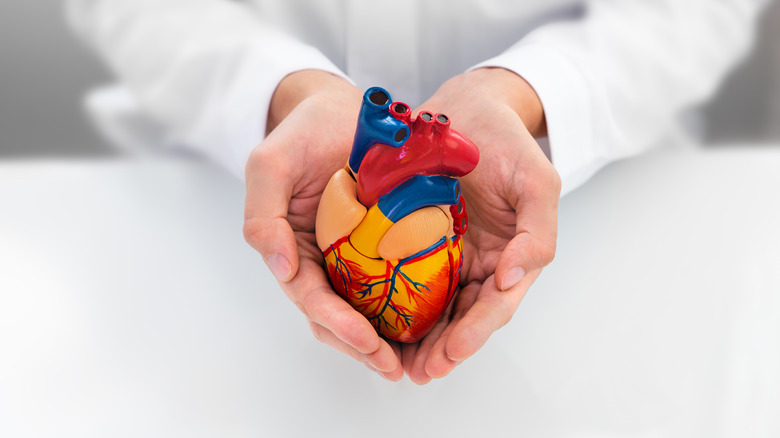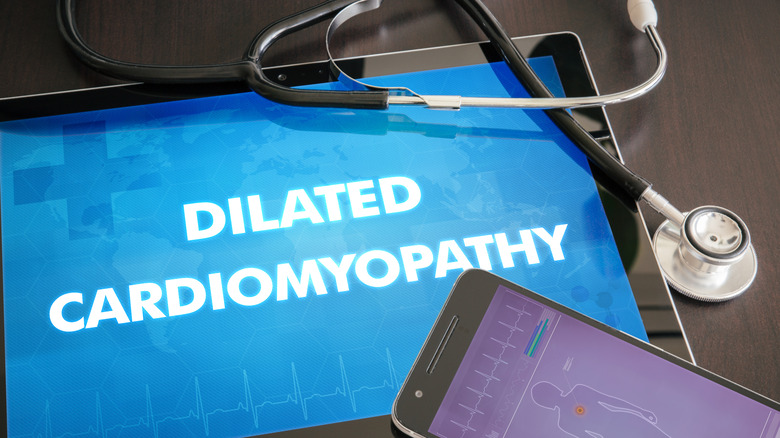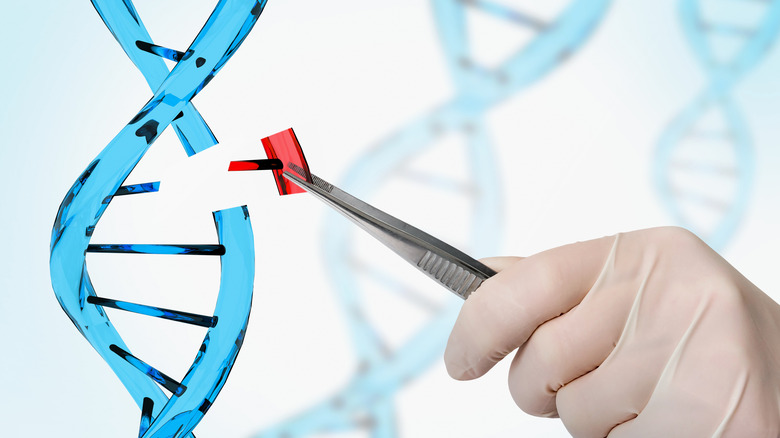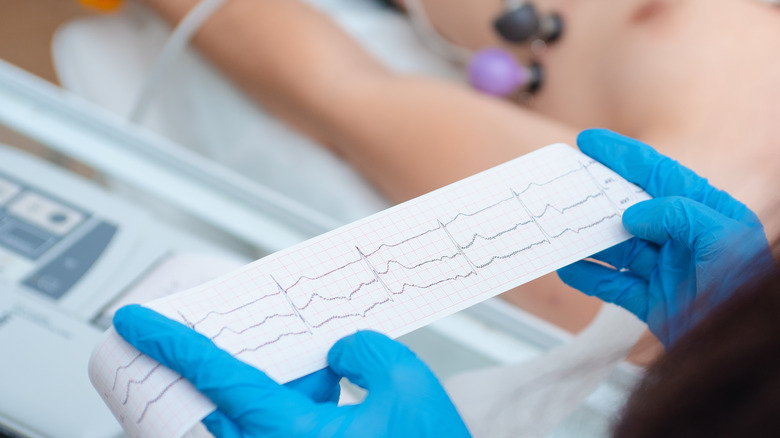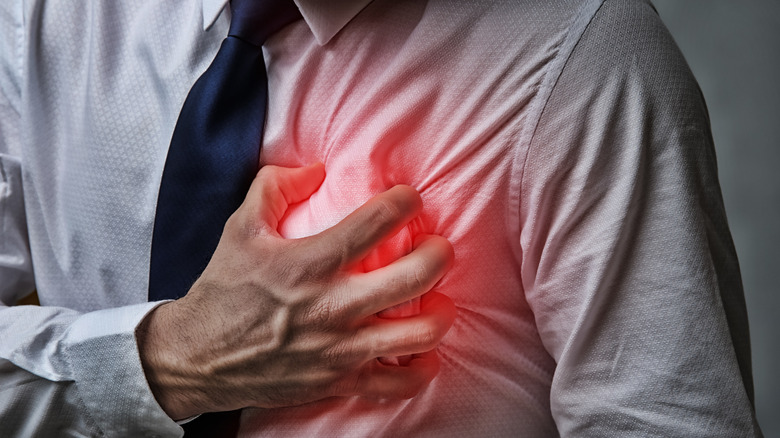Cardiomyopathy Explained: Causes, Symptoms, And Treatments
Cardiomyopathy is a heart condition characterized by a weakened ability of the heart muscle to pump blood, reports the Centers for Disease Control and Prevention (CDC). This may result from the heart muscle becoming enlarged, thicker, stiffer, or scarred. The diminished blood flow can cause blood to backup into the lungs and other parts of the body. Some people with cardiomyopathy may develop irregular heartbeats and even heart failure.
Cardiomyopathy can be passed down through a parent's genes or it can develop from another condition. As described by Johns Hopkins Medicine, there are three main types of cardiomyopathies: hypertrophic cardiomyopathy, dilated cardiomyopathy, and restrictive cardiomyopathy. Another type, arrhythmogenic right ventricular dysplasia (ARVD) is rare.
While the cause of cardiomyopathy is often unidentified, some of the many known causes include high blood pressure, coronary artery disease, and viral infections. Several features distinguish cardiomyopathy from other heart conditions. For instance, cardiomyopathy tends to get worse over time and sometimes deteriorates rapidly. Dilated cardiomyopathy usually progresses to heart failure and is a principal cause of heart transplantation. While cardiovascular disease predominates among older adults, cardiomyopathy can occur in young populations. Lastly, cardiomyopathy can be associated with conditions that involve organs other than the heart.
Common symptoms of cardiomyopathy include fatigue, shortness of breath and heart palpitations (via the Cleveland Clinic). While there is no cure for cardiomyopathy, medical treatment and lifestyle changes can help to manage the disease and limit its progression. A heart-healthy diet and habitual exercise are of prime importance in minimizing symptoms and improving heart health.
Types of cardiomyopathies
The American Heart Association broadly categorizes cardiomyopathy as primary or secondary, but with frequent overlap (via a 2021 review of studies in the International Journal of Molecular Sciences). Primary cardiomyopathy is primarily restricted to the heart; however, in secondary cases the heart condition develops as part of a systemic disorder that affects other organs. Of the three main type of cardiomyopathy, reports Johns Hopkins Medicine, dilated cardiomyopathy occurs most frequently and is distinguished by a heart that is enlarged and stretched, thus impairing its ability to pump out blood.
It is more common in men and can occur in adults of all ages as well as in children. Rarely inherited, dilated cardiomyopathy can be caused by alcohol abuse, infections, or illicit drugs. Hypertrophic cardiomyopathy is associated with thickening of the left ventricle (lower chamber), which may impede blood flow to the body. It is the most common inherited from of cardiomyopathy and can occur at any age, continues Johns Hopkins Medicine. People with hypertrophic cardiomyopathy may develop arrythmias (irregular heartbeat), which can cause sudden death. The third major type of cardiomyopathy — restrictive cardiomyopathy — is marked by stiffness of the heart muscle that compromises its ability to relax and fill up with enough blood to pump out. It is the least common type in the United States and "often occurs due to an underlying problem, such as amyloidosis, hemochromatosis, scleroderma, or sarcoidosis" (via Johns Hopkins Medicine).
Arrhythmogenic right ventricular dysplasia (ARVD) is a rare form of cardiomyopathy that causes irregular heart rhythms and can trigger sudden cardiac arrest in young athletes.
Prevalence of cardiomyopathy
The different types of cardiomyopathies vary in their prevalence, reports a 2021 review of studies published in the International Journal of Molecular Sciences. The most common primary (mainly confined to the heart) cardiomyopathy — hypertrophic cardiomyopathy (HCM) — has a prevalence of one in 500 people. Another common type — dilated cardiomyopathy — has a prevalence of one in 2,500 and mostly affects people 40 to 59 years of age. According to a 2020 study published in the Journal of Clinical Medicine, the "public health burden" of cardiomyopathies with respect to hospitalizations and invasive therapeutic procedures is substantial.
Cardiomyopathies are now ahead of coronary artery disease as the leading indicator for heart transplants, accounting for 51% of all heart transplants. Cardiomyopathies are also responsible for an appreciable 11% of hospitalizations with regard to heart failure. These proportions are considerably greater in patients under the age of 40 who represent 71% and 23% of heart transplants and heart failure, respectively. In accordance with these findings, and as advised by the 2020 study authors, public health action programs aimed at improving early diagnosis and prevention of recurrence of cardiomyopathies should direct their focus on people under 40 years of age.
Causes of cardiomyopathy
As explained by the National Heart, Lung, and Blood Institute, some types of cardiomyopathies occur as a result of gene mutations that cause the heart to form and develop abnormally. These gene mutations can be passed down through families from generation to generation. Hypertrophic cardiomyopathy (one of the three major types of the disease) as well as arrhythmogenic cardiomyopathy are usually inherited. Rather than being genetic in origin, other forms of cardiomyopathy are acquired, i.e., they are secondary to another condition or disorder (via the Mayo Clinic). Although the cause of cardiomyopathy is often never determined, some conditions can lead to the development of the disease.
Cardiovascular conditions implicated include long-term high blood pressure, heart damage from a heart attack, prolonged rapid heartbeat, heart valve issues, and excessive accumulation of iron in the heart (hemochromatosis). Other precipitating conditions are metabolic disorders (e.g., diabetes, obesity, or thyroid disease), connective tissue disease (e.g., Rheumatoid arthritis, lupus), and certain infections, including Covid-19 and, in particular, infections that cause cardiac inflammation.
Cardiomyopathy can also develop from rare disorders such as amyloidosis (abnormal buildup of proteins in organs) and sarcoidosis (clumps of inflammatory cells – granulomas – form in organs including the heart and lungs), continues the Mayo Clinic. Unhealthy lifestyle habits such as long-term alcohol abuse, poor diet, cocaine, amphetamines, and anabolic steroids, complications around pregnancy, and cancer treatments (e.g., chemotherapy, radiation) may also lead to cardiomyopathy.
Risk factors for cardiomyopathy
Certain lifestyle habits that raise the risk of cardiomyopathy are modifiable, reports the NIH. These unhealthy addictions include cocaine, amphetamines, and excessive alcohol. Women should limit their drinks to one per day while men should top off at two drinks per day. Extreme stress can increase the risk of a rare condition called takotsubo cardiomyopathy, also known as broken-heart syndrome. Risk factors that can't be controlled include a family history of cardiomyopathy or other heart disorders as well as chemotherapy and radiation treatment for cancer.
A number of diseases can also increase the likelihood of developing cardiomyopathy (via the Mayo Clinic). Disorders such as obesity, high blood pressure, and diabetes can adversely affect the heart muscle. Obesity, for example, forces the heart to pump harder. High blood pressure and high blood sugar (diabetes) can both inflict damage to blood vessels, notes the Centers for Disease Control and Prevention (CDC). These lifestyle-related disorders can be improved through a healthy diet, exercise, weight loss, and stress management.
Other conditions that increase the risk of cardiomyopathy, continues the Mayo Clinic, include amyloidosis, sarcoidosis, connective tissue disorders, and hemochromatosis (iron overload disease).
Signs and symptoms of cardiomyopathy
As with prevalence, the signs and symptoms of cardiomyopathy vary with the type (via a 2021 review of studies in the International Journal of Molecular Sciences). Symptoms of hypertrophic cardiomyopathy may be related to abnormal heart rhythms (arrythmia) and can include difficulty breathing (especially when physically active), chest pain, heart palpitations, or fainting. Some people with hypertrophic cardiomyopathy may have only a few or no symptoms for an extended time. Common symptoms of dilated cardiomyopathy include shortness of breath and fatigue as well as swelling in the ankles, feet, legs, abdomen, and veins in the neck, reports the American Heart Association. The dilation, or widening, of the heart weakens its contractions, potentially resulting in heart failure.
As with hypertrophic cardiomyopathy, people with restrictive cardiomyopathy may be asymptomatic or may experience only minimal symptoms (via WebMD). Symptoms can occur at any age and can become more severe as the heart progressively worsens. They include shortness of breath, fatigue, inability to exercise, swollen legs and feet, chest pain, weight gain, fainting, palpitations, nausea, bloating, and reduced appetite.
Diagnosis of cardiomyopathy
Diagnosis of cardiomyopathy begins with a medical and family history that includes any signs and symptoms of the disease, reports the American Heart Association. A physical exam is also performed to look for specific signs and sounds that may indicate cardiomyopathy. For example, a heart murmur or crackling sound in the lungs may be signs of hypertrophic cardiomyopathy and heart failure, respectively. Other symptoms that may signal heart failure include swelling of the feet, legs, and abdomen due to edema (fluid buildup). Blood tests and various other tests may then be recommended to diagnose cardiomyopathy.
A chest X-ray can detect an enlarged heart or excess fluid in the lungs while other tests are performed to assess the electrical activity of the heart, e.g., electrocardiogram (EKG or ECG) and Holter and event monitors. By providing an ultrasound image of the heart, an echocardiogram is used to evaluate the structure and function of the heart while a stress test can determine how well the heart works when it's beating fast.
As described by the National Heart, Lung, and Blood Institute, a diagnosis of cardiomyopathy is confirmed with procedures such as a cardiac catheterization whereby a catheter is threaded to the heart via a blood vessel in the arm, groin, or upper thigh, or neck. Catheterization may be used to collect a heart biopsy or to perform a coronary angiography. A coronary angiography is another confirmatory test that involves the use of a contrast dye and X-rays to study blood flow and locate coronary arteries that are blocked or narrowed by plaque buildup.
Medical treatment of cardiomyopathy
The medical treatment for cardiomyopathy is determined by any underlying disorders that preceded the development of the disease as well as by the particular type of cardiomyopathy, explains the Centers for Disease Control and Prevention (CDC). The main goals of treatment are to manage symptoms, delay the progression of the disease, and prevent severe outcomes such as sudden death.
A variety of medications may be used to treat symptoms and underlying conditions, reports the Cleveland Clinic. For example, blood thinners such as warfarin (Coumadin) can help prevent blood clots while beta blockers such as propranolol (Inderal) lower blood pressure. Other medications are used to treat high cholesterol levels. Sometimes surgically implanted devices may be necessary to improve heart function.
Patients with irregular heartbeats may need a pacemaker or implantable cardioverter defibrillator (ICD) to monitor heart rhythms and deliver electrical impulses as needed. In other patients, a left ventricular assist device (LVAD) may be used to improve blood flow through the heart. Non-surgical therapies include ablation procedures that destroy areas of heart tissue, notes the Mayo Clinic. Septal ablation targets segments of thickened heart muscle to improve blood flow through the heart while radiofrequency ablation is used to treat irregular heart rhythms. Open-heart surgery or a heart transplant are last resort treatments for severe cases of cardiomyopathy.
Lifestyle changes for cardiomyopathy
As recommended by the American Heart Association, lifestyle changes play an important role in disease management and prevention of complications. A heart healthy diet should include a variety of fruits and vegetables, whole grains, lean meats, poultry, fish, beans, and low-fat dairy foods. Foods high in sugar and salt should be avoided as well as excessive alcohol. To achieve and/or maintain a healthy weight, food should be balanced with regular exercise.
However, before starting an exercise program, people with cardiomyopathy may need medical consultation if they are on medications or having symptoms such as shortness of breath, chest pain, or dizziness. Quitting smoking, managing stress, and getting good-quality sleep are additional lifestyle changes that can help improve heart health.
Ongoing medical care is also important for people with cardiomyopathy (via the National Heart, Lung, and Blood Institute). This includes doctor's appointments and routine heart and blood tests to evaluate the effectiveness of the treatment. Medications should always be taken as prescribed, and any adverse effects (e.g., depression, dizziness, abnormal heartbeats) should be reported to the doctor. It's also essential to report worsening of symptoms or any new symptoms such as swelling of the ankles, feet, legs, abdomen, or veins in the neck.
Complications of cardiomyopathy
Complications of cardiomyopathy can damage the heart and the brain, reports the NIH. Some people with the disease may experience arrythmias whereby disruption of the heart's electrical system causes the heart to beat too fast, too slow, or at irregular intervals. In other people with cardiomyopathy, the heart valves may become damaged. These valves have flaps that regulate blood flow in the right direction by opening and shutting with each heartbeat. Sometimes the heart is so weakened or damaged that it cannot pump sufficient blood and oxygen to the brain, kidneys, and other organs. This can lead to a potentially fatal condition called cardiogenic shock. Moreover, pooling of the blood in the heart can trigger the formation of blood clots which can impede blood flow to the brain and possibly cause a stroke.
If not treated, the inability of the heart to pump enough blood to the body can result in life-threatening heart failure, notes the Mayo Clinic. In some cases of cardiomyopathy, the heart may abruptly stop beating, causing cardiac arrest and sudden death.
Pregnancy and cardiomyopathy
According to a 2018 review of studies published in the journal Heart, cardiomyopathy associated with pregnancy most often occurs in the month before or after birth of the baby. This type of cardiomyopathy is referred to as peripartum cardiomyopathy (PPCM). Globally, the incidence of PPCM varies greatly form one in 100 to one in 20,000 deliveries. It develops most frequently in African countries and least often in Scandinavia and Japan. PPCM is likely caused by a variety of factors including inflammation and genetic susceptibility.
In addition to African ethnicity, risk factors for PPCM include malnutrition, high blood pressure during pregnancy (preeclampsia), and existing medical conditions or lifestyle habits, e.g., infections, obesity, autoimmune disorders, smoking, excess alcohol consumption (via the National Heart, Lung, and Blood Institute). Other risk factors are multiple previous pregnancies or a pregnancy with more than one baby, taking medications harmful to the heart, and age (older than 35 or very young). Women with pregnancy-related cardiomyopathy may experience symptoms of heart failure such as shortness of breath, fatigue, and fluid retention in the legs.
It's essential for women to report these symptoms to their physician since they can be mistaken for normal pregnancy symptoms. During and after their pregnancy, women with PPCM must be carefully monitored by the healthcare team for serious symptoms (e.g., low oxygen levels) that can potentially lead to complications.
Prognosis of cardiomyopathy
Cardiomyopathy is a serious, life-threatening type of heart disease that worsens over time, reports the Cleveland Clinic. Nevertheless, treatment with medicines, surgery, or other modalities can improve outlook and quality of life. The prognosis varies among the three major types of the disease. According to Medscape, many people with dilated cardiomyopathy progress to heart failure. If heart function continues to deteriorate, mechanical circulatory support (e.g., LVAD, artificial heart) or a heart transplant may be required. Higher death rates from heart failure are associated with certain risk factors, including increasing age, male sex, and severe congestive heart failure (CHF).
While more than half of patients with severe heart failure die each year, those with mild heart failure have a much better outlook. Death rates for people with hypertrophic cardiomyopathy are also high, though they have markedly improved over the past four decades, notes Medscape. The death rate for this type is considerably higher in younger patients, especially children. In many cases, death occurs suddenly and without any warning signs.
It is often related to sports or any intense activity. People with hypertrophic cardiomyopathy are at high risk of recurrent heart failure. Among the major types of cardiomyopathies, restrictive cardiomyopathy has the worst prognosis, especially in children with heart failure (via Medscape). In people with this type of cardiomyopathy, the heart progressively deteriorates along with potential complications such as blood clots and pulmonary hypertension (high blood pressure in the arteries leading from the heart to the lungs). The five-year death rate for restrictive cardiomyopathy is 70%.

